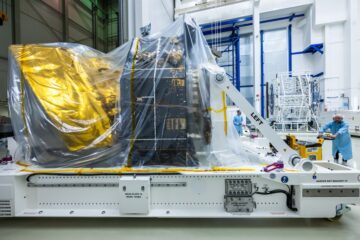Questions asked by Heather Alexander
Questions answered by Rok Nezic
What conference did you go to recently and where was it held?
I attended the European Planetary Science Congress (EPSC), an annual meeting of planetary scientists which this year took place at the Technische Universität Berlin from 16th to 21st September. EPSC is an annual meeting, and this year it was attended by over 1000 people. There were 6 parallel sessions running from Monday to Friday (8:30am till 8pm most days), so it was extremely busy: I estimate there were over 600 talks given, and several hundred posters presented.
How long where you there?
I flew in on the evening of Saturday 15th September and flew back on the evening of Monday 24th, partly because flights on those dates were cheaper and partly because I had never been to Berlin before, so I was quite looking forward to exploring it a bit!
Did you give a talk at this conference?
Yes! I gave a talk entitled ‘Linear polarisation of comets observed with STEREO’ on Thursday, as part of the ‘Interpretation of observational data using spectro-polarimetric techniques’ session within the ‘Small Bodies’ section of the conference (dealing with comets, Kuiper Belt objects, asteroids, meteorites, etc.). In it I presented some results of my analysis of comet observations of the STEREO spacecraft (‘Sun Earth Connection Coronal and Heliospheric Investigation’). The images I looked at were taken with polarising filters (very much like the ones you might find on polarised sunglasses) and they can tell us more about the properties of comets. In my case, it turns out the properties of those comets are… very strange indeed.
Were there any social events at this conference?
Yes, there were a few social events organised. There was a conference dinner of sorts organised at a famous biergarten in Berlin, but I didn’t actually end up going to it. There were also several small events for young scientists to help us with networking and similar, which was lovely.
Did anything unexpected happen?
I think the whole thing went rather smoothly from start to finish, so nothing particularly springs to mind. For me personally a very unexpected thing was that I won a prize at the ESA (European Space Agency) stand: a model of comet 67P/Churyumov–Gerasimenko, the mission to which ESA’s Rosetta spacecraft finished on 30th September 2016, almost exactly 2 years ago now (and also my birthday, as it happens). I won the prize for (correctly!) completing a quiz which was focused on Rosetta (ESA’s last big mission) and BepiColombo; it and JAXA’s (Japan Aerospace Exploration Agency) new big mission to explore Mercury, which is planned to launch in a few weeks; on 19th October 2018. I am extremely excited about my prize because I have followed the work of Rosetta very closely, and I’ve actually worked on some 67P data for my PhD!
Did you have a favourite talk or discussion group that you attended?
Yes, my favourite session was (unsurprisingly, considering my previous answer) the Rosetta one, which spanned Thursday afternoon and the entirety of Friday.
Could you give a brief highlight of the subject matter?
The Rosetta spacecraft was launched in 2004 and had a long and complex orbit which meant it met up with comet 67P/Churyumov–Gerasimenko in August 2014, and then stayed there doing a huge amount of science for over two years, ending the mission on 30th September 2016. It had a great number of instruments on board, looking at everything from dust grains floating nearby to the comet interior using radar. It did a lot of various types of spectroscopy and of course it also took thousands of photos of the comet and its surface. It also sent a lander (Philae) onto the surface, which unfortunately bounced off the dusty layer it was supposed to land on and instead eventually got stuck in a crevasse where little sunlight could reach it. Still, Philae did its best to get on with its science, and all of the instruments on both the mother spacecraft and the lander gave us a huge amount of data about the comet and how it was changing as it reached perihelion (the point in its orbit closest to the Sun; that is more or less when its activity is at its peak because of the intensity of sunlight). Even though its mission ended 2 years ago now, the data is still being analysed and new conclusions drawn, new things spotted in the images, etc., so it’s really exciting to follow the progress of science in that field. Analysis of that data will certainly continue for several decades to come. For example, one of the talks presented at the conference was looking at images which happened to contain not just dust and rocks, but exposed white patches – which can only be ices (water ice, CO2 ice…) normally hiding just under the surface – and looking at how they evolve. Another one looked at boulders on the surface and watched how some of them moved around with time, meaning there’s something that is causing the surrounding material to ‘flow’. Yet others looked at how rock layers seem to be oriented across the surface of the comet and inferred from that how the layers should continue through the interior of the comet.
Would you like to see a conference like this held at Armagh Observatory and Planetarium?
Sure, bringing top-notch science closer to home would always be nice, however I think this particular format (>1000 attendees, 6 parallel sessions) would be logistically rather unfeasible in Armagh. A smaller meeting with a more specialised interest, however – certainly!
If you could sum up the conference in three words, what would they be?
That’s actually very difficult, because it depends on what I want to highlight! Some of the summaries I could give you are:
‘Solar System Science!’
‘Comets are cool!’
‘Planets are interesting!’









0 Comments